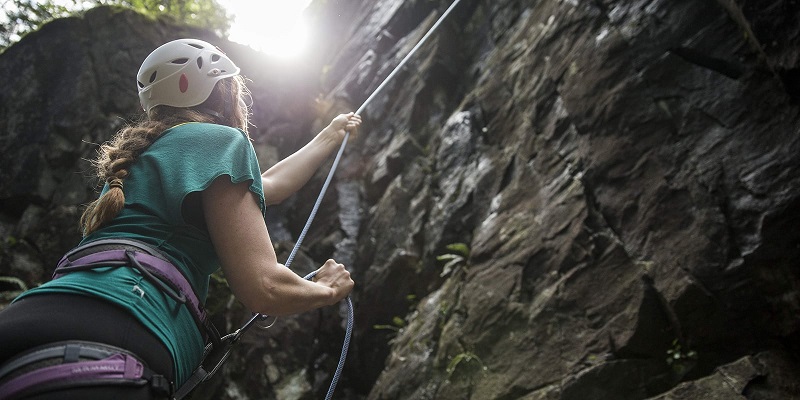Usually, every climber clinging to fitness center or a rock face has a spouse doing a role. The rope is skillfully handled by the belayer and could be relied on to catch each time the need arises.
Belaying is a skill that scaling courses teach and instruction from an experienced instructor is indispensable. This report covers the fundamentals of belaying that is top rope but is not supposed to replace instruction.
The Essential measures in learning how to top-rope belay comprise:
- Gearing up
- Set-up
- Communication
- Technique
Gearing Up to Belay
If you choose a belay course, usually a rope, harness, helmet (if climbing outside), locking carabiner, belay device and rock sneakers are provided or available for lease. Check whether you have to bring any equipment to find out.
Kinds of belay devices: Your belay device is utilized to control rope slack/tension, grab a drop and lower your climbing partner. Both major device forms are brake assist and tubular.
This report covers using a device that is tubular. Techniques change for several reasons. If you select another kind of apparatus you were taught to utilize you have to understand and practice methods. A couple details differ though fundamental belay is comparable on a lot of devices. And belaying a climber can be very different, particularly on a device.
Setting Up the Belay
- While the climber ties into the tap using a figure 8 knot, you Want to do several measures:
- Close to the machine by linking a stopper knot at the end of the rope. This ensures that your end of this rope won’t ever pass entirely decreasing the climber.
- Once the climber is a lot heavier than you, additionally look at tying into a ground anchor. Earth anchors are well worth considering, also, whenever you are made to belay at a spot that less than perfect: in which you’ve got an obstruction between you and the walls, for instance.
- Setup the belay device by slipping a bight of rope by means of the tube nearest to a dominant hand. A few have a surface that is grooved on one side of each tube Although belay devices are symmetrical: This supplies friction if desired to belay a climber or to belay.
- The facet of this bight, which extends back down and up into the backbone to the climber, should be on the facet of your device.
To prevent stressing the cable ensure that the rope bight does not cross the cable on.
Performing the Security Check
The climber and belayer the installation of each other before climbing:
- Knots: Is your climber’s figure 8 tied properly and did the belayer shut the machine properly with a stopper knot?
- Buckles: Are harnesses comfortable with buckles firmly secured? When it’s inherent in the buckle layout or (on elderly harnesses) that the climber must execute the job, straps need to double through buckles to fasten them. Is it true that the carabiner pass throughout belay-device cable the rope and belay loop? Is your carabiner locked?
- Control Assess: As terms may vary, run through your communicating to assess language and to make sure that you agree on each term you may utilize.
Belay Communication
Be eloquent with them, since miscommunication can be as consequential as any sort of failure. Review orders to make sure your spouse and you are on precisely the exact same page. Here are the controls that are common:
Climber: “On belay?” (Are you ready to belay me?)
Belayer: “Belay on.” (Slack is gone and I’m ready.)
Climber: “Climbing.” (I’m going to climb now.)
Belayer: “Climb on.” (I’m ready for you to climb.)
Climber: “Slack!” (Pay out a little rope.)
Belayer: (Pay out rope and pause to see if climber asks again.)
Climber: “Up rope.” (Pull in rope slack.)
Belayer: (Pull in slack and pause to see if climber asks again.)
Climber: “Tension.” (I want to rest by hanging on the rope now.)
Belayer: (Remove all slack and hold tight.) “Gotcha.”
Climber: “Ready to lower.” (I’m done climbing.)
Belayer: (Reposition both hands to brake.) “Lowering.”
Climber: “Off belay.” (I’m standing securely on the ground.)
Belayer: “Belay off.” (I’ve stopped belaying you.)
The argument for using “stress” rather is that “take” could be mistaken with “idle,” and perplexing those orders could be an extremely poor thing.
Naming titles: Start every control with your spouse’s name. On a crag or within a fitness center, voices are tough to differentiate. 1 way your spouse will be aware that you were come from by the control will be to include the title of your partner.
Other significant Upgrades: Should you hear these shouted by a climber, with or without a title, prepared.
- “Rock!” This is for anything, natural or manufactured, that gets loose. When you hear this, look down (not up) so your helmet can protect you.
- “Watch Me!” This means a climber thinks a fall is likely.
- “Falling!” Means exactly what you think it means.
Belay Technique
The following are universal belay principles:
- This is really for anything, manufactured or natural. If you listen to that, look down (not up) so that your helmet will protect you. This usually means a climber believes there is a drop likely. Means. ALWAYS.
- Just slide a hand once the rope is held at the braking position.
- Always orient brake palms in their most powerful natural place.
- Always keep focus on your own climber and be alert to any dangers on your environment.
Suitable Belay Stance
- Athletically, that signifies your non-dominant foot goes forward, your knees are bent, and your entire body is relaxed yet prepared.
- Geographically that usually means you are not too far in the wall. To prevent impact in even a stone or the climber, you are also 1 step away from becoming directly beneath the path of the climber.
- Organizationally, that usually means any rope on the floor is stacked so it will not get tied up because you are belaying. (Notice: Should you place your brake hand too near the apparatus, you risk getting seriously pinched through a forceful autumn, which in turn, puts you in danger of dropping the rope) Grab it over your head.
PBUS (Bring, Brake, Beneath, Slide) Strategy
Almost all of your time is spent shooting in slack since the individual climbs when you are belaying a climber. The PBUS Procedure is a way:
- Pull: Pull your manual hand back while also lifting the securely gripped brake rope outside and up. As your spouse climbs this happens in slack.
- Brake: once the manual hand nears the belay device, reverse the brake rope down to lock the rope from the gadget.
- Beneath: Transfer the manual hand into the brake rope, then putting it under the brake hand. The rope that is grip securely to make a temporary hand.
- Twist: Loosen the grip, but do not unwrap the palms of your initial brake hand. Twist it up six inches below the device, to its first place, and hold the rope.
- Duplicate: Transfer your manual hand back into its first position and you are all set to go back again. Usually, short PBUS sequences operate.
See and listen to a climber always and carefully. You pause After the climber pauses. Consistently pause in the brake place. You must be ready maintain tension, to grab a drop and decrease your climber.
Obtaining a Fall
When it’s as you listen to the climber shout “Falling!” And/or since you can’t ever take your eyes away from your own climber you spot, you need to respond. That is why your belay posture is essential.
- Yank on your brake down since you tighten your grip.
- Utilize your entire body, harness, rope and belay device to absorb the power of the collapse.
Your own body is currently acting as a counterweight to the body of the climber. the space the climber falls will be small, if you have been eliminating slack throughout the scale.
Be aware that scaling ropes are intended to extend and, in turn, reduces the pressure on the body of the climber throughout the autumn.
Holding a Climber Who’s Pauses
Each time a climber wishes to pause for any reason–to break, think about a movement or is on peak of the scale, such as –that the control is “Tension!”
- Remove any slack in the rope
- Pull your brake hand down
- Lean back to maintain rope tension
- Yell “Gotcha!”
Lowering a Climber
once the climber has completed the road, asked for anxiety and you have them the climber will lean into a sitting posture and shout, “Lower me”
- Allow the rope gradually to feed throughout the belay device, lowering the climber
- Maintain a constant speed, adjusting speed when the climber asks it
- Pause to Allow the climber view and negotiate challenges like a stone outcrop, a roof or an overhang
- Slow down near the floor to allow the climber to touch with great footing
After the climber is position on the floor, safely balanced on 2 toes, the climber yells “Off belay!” You react by paying plenty of crying and idle “Belay off!”
Recall: Growing security is the own responsibility. No online post or movie may replace appropriate instruction and expertise –this report is meant solely as supplemental info. Make sure you’re practiced in appropriate procedures and safety conditions until you climb.

